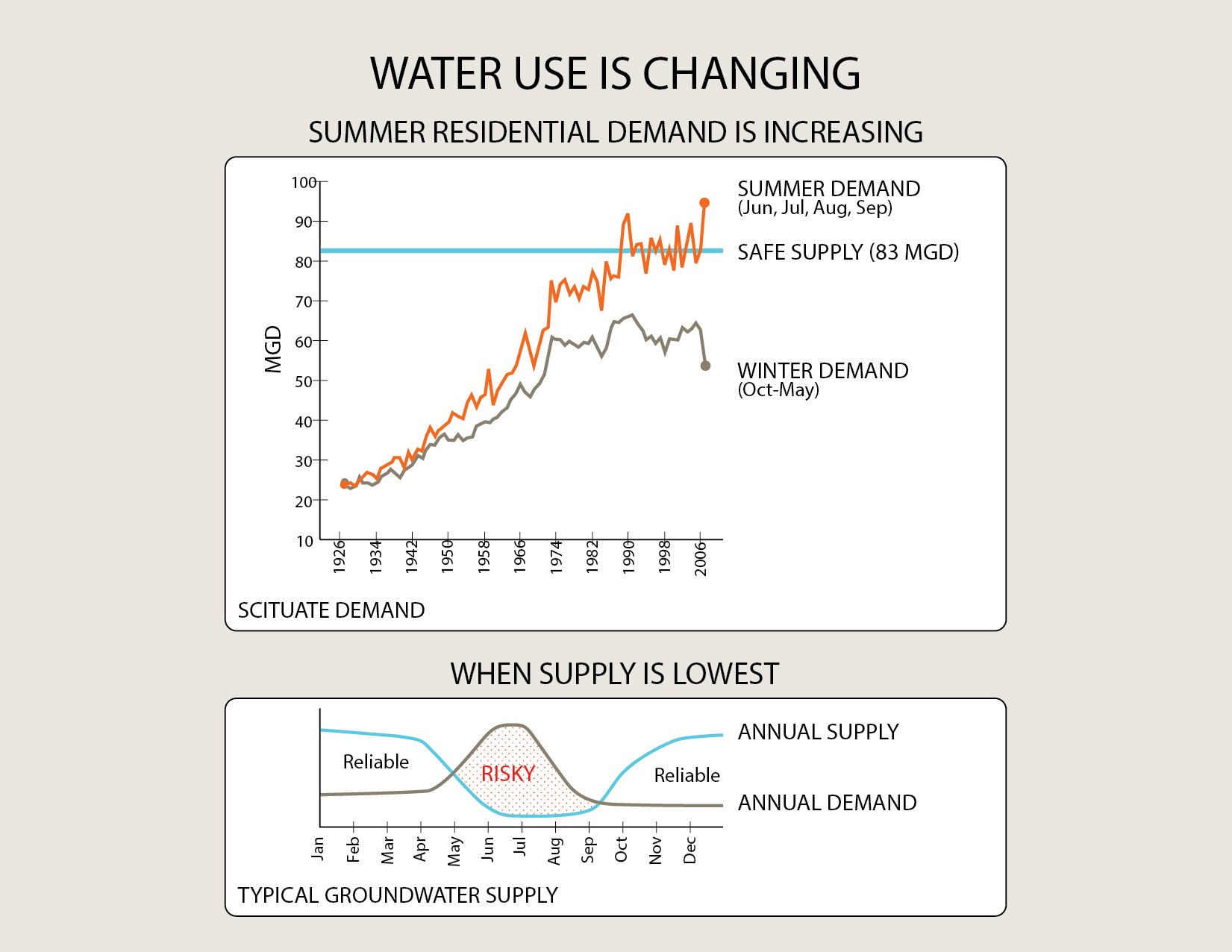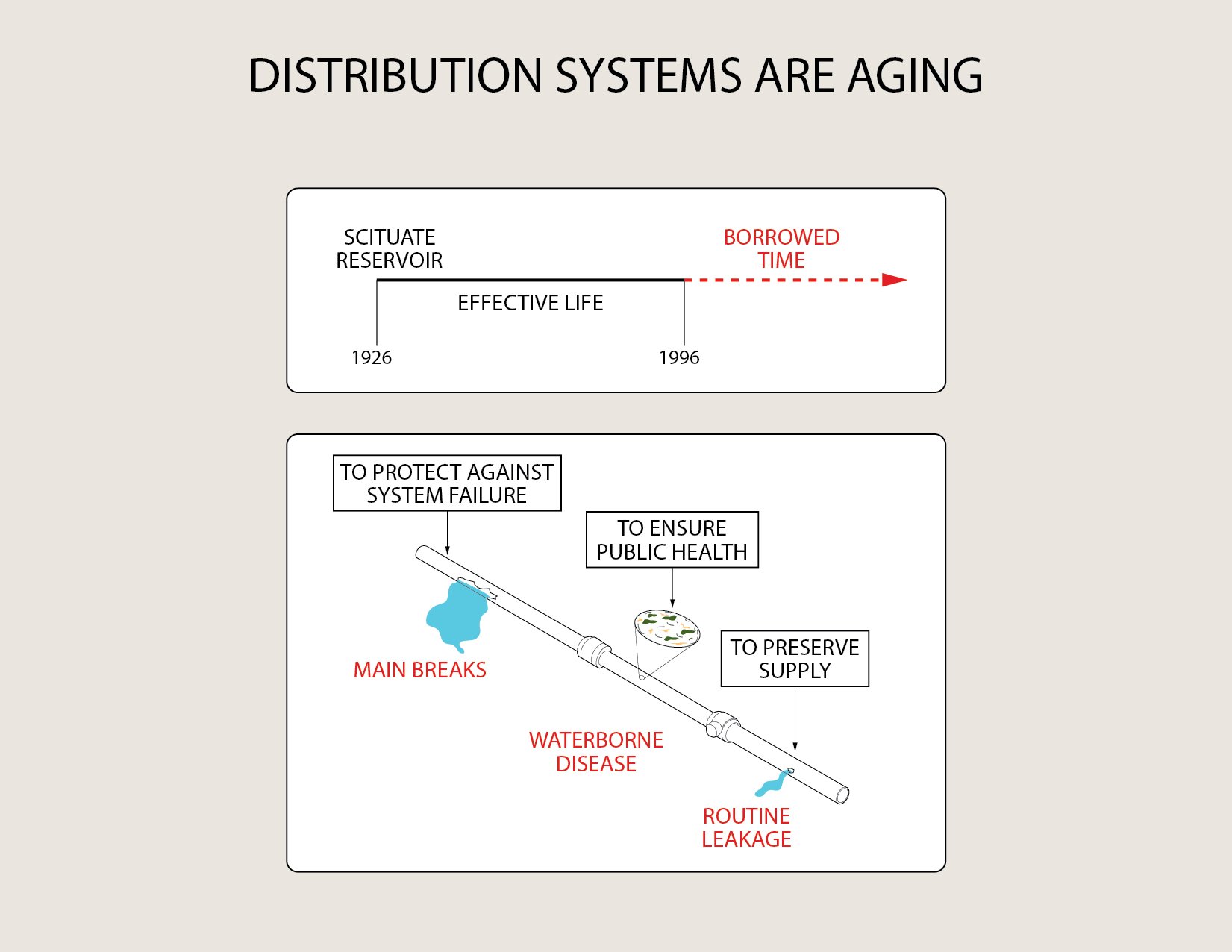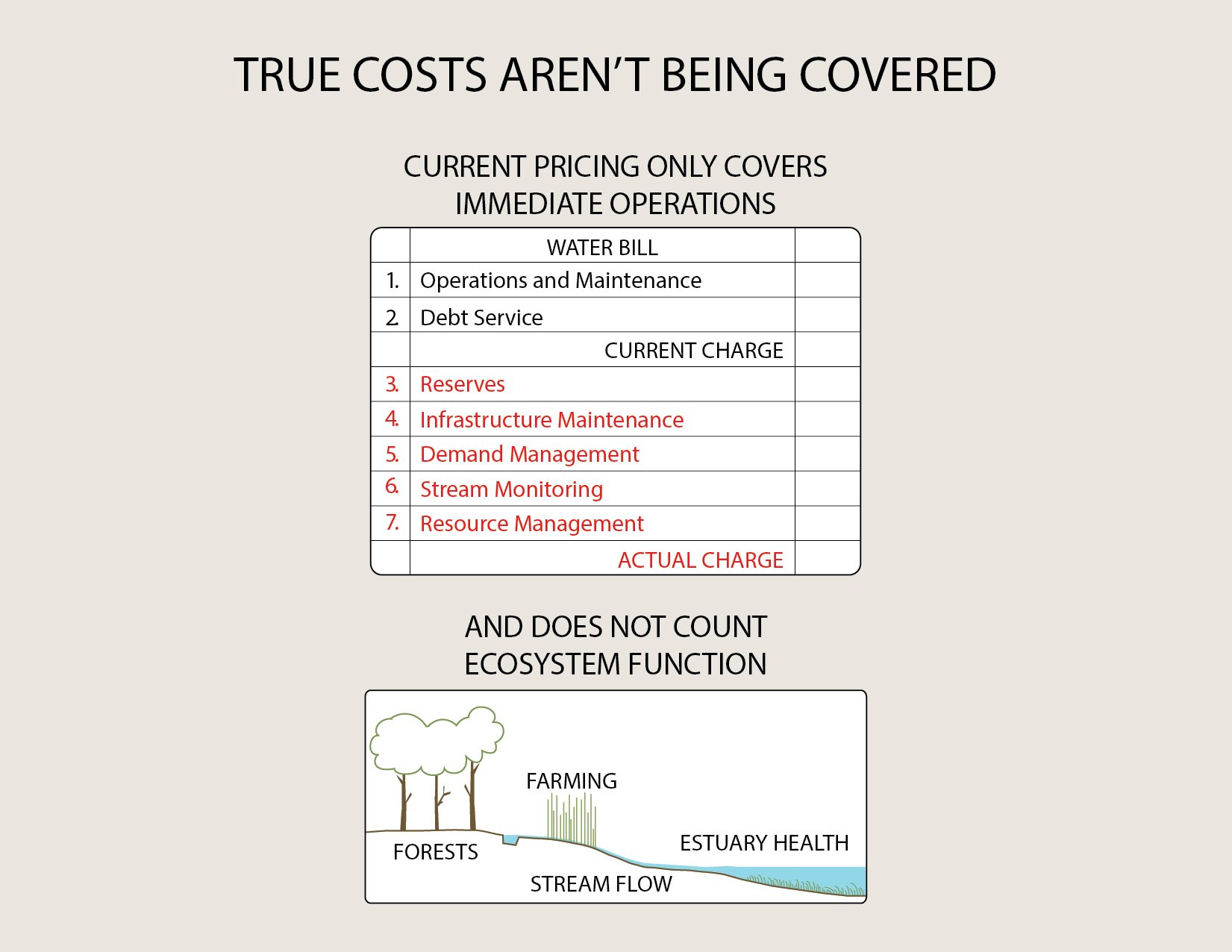Rhode Island waterfutures
LOCAL was commissioned by the Rhode Island Economic Policy Council to create a series of images
that identified the issues the State needs to address to secure its water supply. These images were used
to define the terms of the debate over appropriate investment. Following is the full presentation and text:

HOW DOES RHODE ISALND GET ITS WATER Reservoirs (stored surface water) supply 85% of Rhode Islanders’ water needs. Well water, drawn from flowing ground and surface water, supplies 15% of the State’s water use. Three factors are stressing RI’s water resource: (1) high rates of development in communities served by well water, (2) rising per capita summer residential water use, and (3) the contamination of some water supplies. In communities served by private wells, increased water usage not only draws down the local water table which can harm adjacent farms, forests, and streams, but also in some places intercepts waters that feed downstream public water supplies. Map Data and Statistics: Water Resources Board, RI Drinking Water Supply Resources, Feb. 7, 2007

THE WAY WE USE WATER IS CHANGING Prior to the 1990’s industrial water use accounted for half of the total water budget. Industrial water use is down 30% since 1990, while overall water use is up 12%. Residential and commercial now account for 75% of water use. Climbing summer peak water use is now the biggest water budget issue. In the summer, Rhode Island uses more water for lawns than for all industry in the state. We are leaving less flowing ground water and stream flow to perform vital functions including diluting and transporting sewage and supporting plant and animal lifecycles. Unlike other uses, residential water use now doubles or triples in the summer when supply is at its lowest driven by an expansion in lawn irrigation. This summer peak is especially hard for areas supplied by groundwater because wells intercept water that feeds streams and rivers. For public supply systems, volatile summer demand increases cost because systems must be sized to meet peak day demand. Sources: Statistics: Lincoln Comprehensive Plan & WRB Graph 1: Harold Ward for the Water Security Coalition based on PWSB data Graph 2: Cynthia Giles for the Water Security Coalition based on PWSB data

AT THE SAME TIME CAPACITY IS DIMINISHING The demand issues are complicated by declining capacity. Over the last few decades a number of water supplies have been taken off line because of deferred maintenance or local contamination. As a result, there are fewer sources. From a systems perspective relying on fewer sources increases our risk. For example, today the Scituate Reservoir supplies 70MGD or about 60% of all the water needs in the State – nearly a 300% increase from 50 years ago. Sources: Map Data and Statistics: Water Resources Board, RI Drinking Water Supply Resources, Feb 7, 2007

AND THE DISTRIBUTION SYSTEM NEEDS AN UPGRADE Many of Rhode Island’s modern water systems were built in the late 20’s and have an effective life of 70 years. This includes both the pipes of individual systems and the larger interconnection systems that link them. The need for infrastructure upgrades may be a more immediate for some communities – like East Smithfield, Johnston, North Kingston and Warwick – where recent data shows non-account water use (which includes leakage and theft) higher than the State specified allotment for water lost in transmission. But all the systems need maintenance and upgrading. Statistics: Water Resources Board, RI Drinking Water Supply Resources, Feb 7, 2007

WATER’S TRUE COST ISN’T REFLECTED IN CURRENT PRICING. Most water bills across the State cover immediate operations without providing revenue needed for improvement, maintenance, and management that will be required of us in the future. In addition we do not account for other ecological process uses (like forests, stream flow and healthy estuaries) that provide vital economic benefit to the State. Statistics: Water Resources Board, RI Drinking Water Supply Resources, Feb 7, 2007

WE NEED TO CHANGE OUR DECISION MAKING STRUCTURE TO PREPARE FOR THE FUTURE. In order to insure that water will be there when we need it, Rhode Island must move to an adaptive water management system that convenes the necessary regulatory agencies and holds them responsible for collaborative decision making. Our water management system needs to develop capabilities that are currently missing. Rhode Island must adopt streamflow standards, assure an adequate reserve supply, and develop the capability to effectively manage water demand.

NEED TO MANAGE WATER USE... If we are going to have healthy streams and an affordable secure water supply even in dry years we need to control summer peak demand. Withdrawing water from ground and surface flow has impacts on our environment, but water is a recyclable resource; the supply of water is only finite if we use it once and discharge it down river. Because water use is one time, and subsidized there are significant opportunities for improvement. Demand Pricing allows people to pay for only what they consume and uses the market to make water use more efficient. Reuse before and after treatment and groundwater recharge after treatment effectively add water to the water budget. Healthy lawns require about one inch of water a week to remain actively growing during Rhode Island summers. This is a lot of water, but many Rhode Islanders are over watering their lawns. A once a week watering policy and an increase in irrigating with recycled water will benefit the flow and quality of streams and groundwater and help balance the water budget.

...AND MAKE INVESTMENTS IN SUPPLY AND DISTRIBUTION We need the many agencies involved in water policy to work together to develop the sources that we need. The right places have been recognized, the issue is that we need to weigh where to put our investment with ecological and safety issues. Sources: Map Data & Statistics: Water Resources Board, RI Drinking Water Supply Resources, Feb 7, 2007

LOCAL LAND USE DECISIONS ARE PART OF THE STORY Local conditions, such as impaired streamflow on the Hunt, Chipuxet, and Queens Rivers could be improved through municipalities encouraging more efficient water use through development practices. Low impact development and onsite water capture, reuse, and ground water recharge ought to be part of the solution. Sources: Colgate Searle, Searle and Searle Landscape Architects Portland OR Storm water Management Guidelines

A VISIONARY POLICY WILL ASSURE OUR FUTURE Rhode Island can have the future we all want with healthy streams, a dynamic economy, disaster resilience, and high quality of life if we act now. Managing water has become more complicated as the margin between the quantity of water we use and the potential water supply grows narrower. Serious problems are emerging because our water management framework just isn’t up to the complexity of the task. We urgently need more adaptive approaches to resource protection, water supply and water use. We need to adopt streamflow standards, assure an adequate reserve supply, and develop the capability to effectively manage water demand. While the necessary changes are significant, they are not radical. Making these changes will help secure Rhode Island’s future as a good place to live and make economic investments.